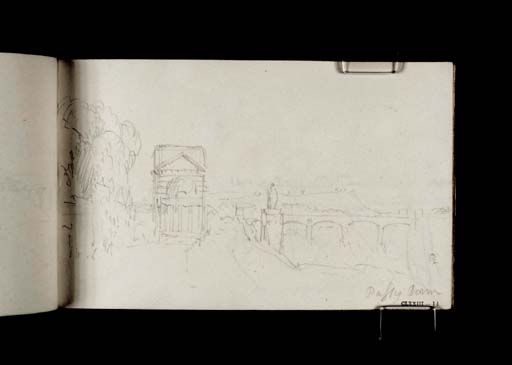Joseph Mallord William Turner The Barrière des Bonhommes at Passy, Paris 1819
Image 1 of 2
Joseph Mallord William Turner,
The Barrière des Bonhommes at Passy, Paris
1819
Joseph Mallord William Turner 1775–1851
Folio 14 Recto:
The Barrière des Bonhommes at Passy, Paris 1819
D14013
Turner Bequest CLXXIII 14
Turner Bequest CLXXIII 14
Pencil on white wove paper, 114 x 185 mm
Inscribed by the artist in pencil ‘Passy [?Barr]’ bottom right
Stamped in black ‘CLXXIII 14’ bottom right
Stamped in black ‘CLXXIII 14’ bottom right
Accepted by the nation as part of the Turner Bequest 1856
References
1909
A.J. Finberg, A Complete Inventory of the Drawings of the Turner Bequest, London 1909, vol.I, p.504, as ‘Paris, from the Barrière of “Passy” ’.
1974
Martin Butlin, Andrew Wilton and John Gage, Turner 1775–1851, exhibition catalogue, Royal Academy, London 1974, p.120 under no.405.
1976
Werner Hofmann, Andrew Wilton, Siegmar Hosten and others, William Turner und die Landschaft seiner Zeit, exhibition catalogue, Hamburger Kunsthalle 1976, p.135 under no.79.
1981
Maurice Guillaud, Nicholas Alfrey, Andrew Wilton and others, Turner en France: aquarelles, peintures, dessins, gravures, carnets de croquis / Turner in France: Watercolours, Paintings, Drawings, Engravings, Sketchbooks, exhibition catalogue, Centre Culturel du Marais, Paris 1981, p.108, reproduced fig.176, as ‘Paris, from the Barrière de ‘Passy’ ’.
1999
Ian Warrell, Turner on the Seine, exhibition catalogue, Tate Gallery, London 1999, pp.19, 230, 252 note 23, 262 note 196, 277 under no.145.
Turner returned to Paris from St-Cloud at the same point at which he had departed, the Barrière des Bonshommes at Passy, which was the entrance to the city on the north bank of the Seine. He had already sketched the structure from the east, see folio 4 (D13997), and this study depicts it from the west.1 The barrière (sometimes known as the Barrière de Passy) was one of a number of gates erected at the end of the eighteenth century as part of the Mur des Fermiers généraux (Wall of the Farmers-General), a city wall built to ensure toll payments on goods entering Paris. They were characterised by neo-classical pavilions designed by Claude Nicolas Ledoux (1736–1806), and the structure at Passy was additionally flanked by large statues standing on square pillars symbolising Brittany and Normandy.2 The gate was demolished during the mid-nineteenth century.3 Turner’s drawing clearly shows the pavilion on the left-hand side with one of the statues on the opposite side of the road beside it. Visible along the top of the hill in the distance are the windmills denoting the Montmartre district of Paris. For a more detailed description of Turner’s Parisian sketches see folio 2 (D13993).
A comparable sketch from a similar viewpoint dates from a late trip to Paris in 1832, see the Paris and Environs sketchbook, 1832 (Tate D24473; Turner Bequest CCLVII 156), and Turner eventually developed the subject as one of his watercolour illustrations for Turner’s Annual Tour, 1835: Wanderings by the Seine (see Tate D24682; Turner Bequest CCLIX 117).4
Nicola Moorby
March 2013
For a contemporary view showing the position of the two statues see a watercolour by J.L.G.B. Palaiseau, Barrière de Passy, 1819 (Bibliothèque nationale de France), reproduced on line at http://gallica.bnf.fr/ark:/12148/btv1b77436636.item.f1.langFR .
How to cite
Nicola Moorby, ‘The Barrière des Bonhommes at Passy, Paris 1819 by Joseph Mallord William Turner’, catalogue entry, March 2013, in David Blayney Brown (ed.), J.M.W. Turner: Sketchbooks, Drawings and Watercolours, Tate Research Publication, August 2013, https://www


